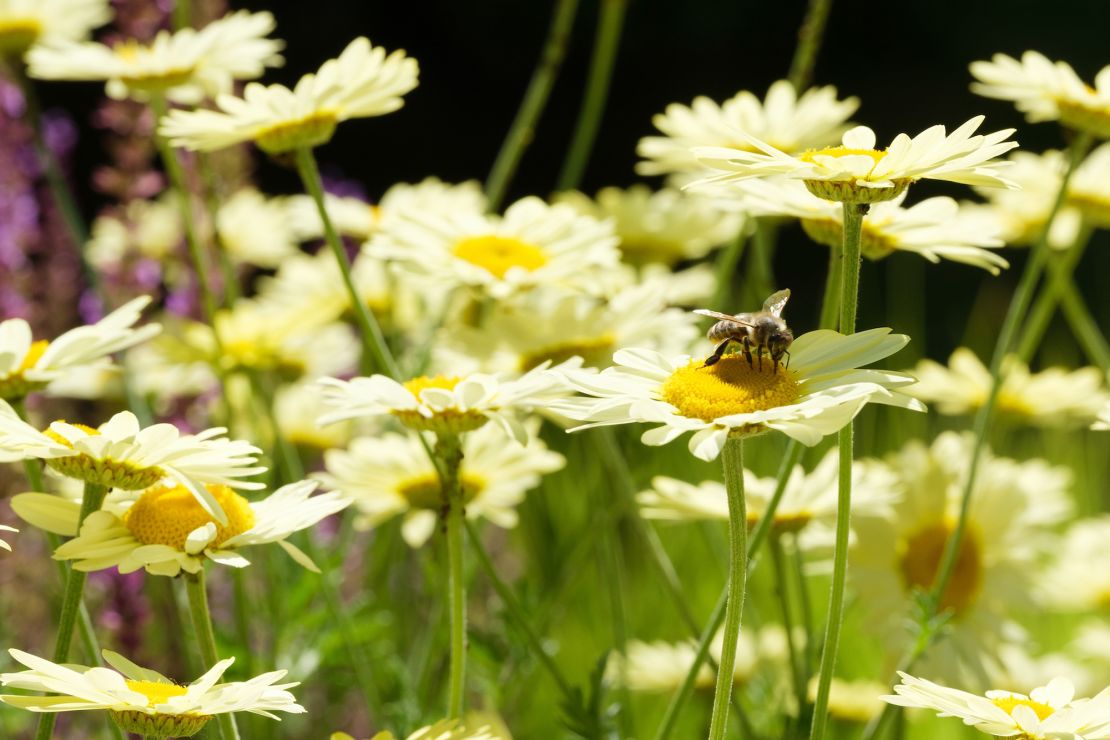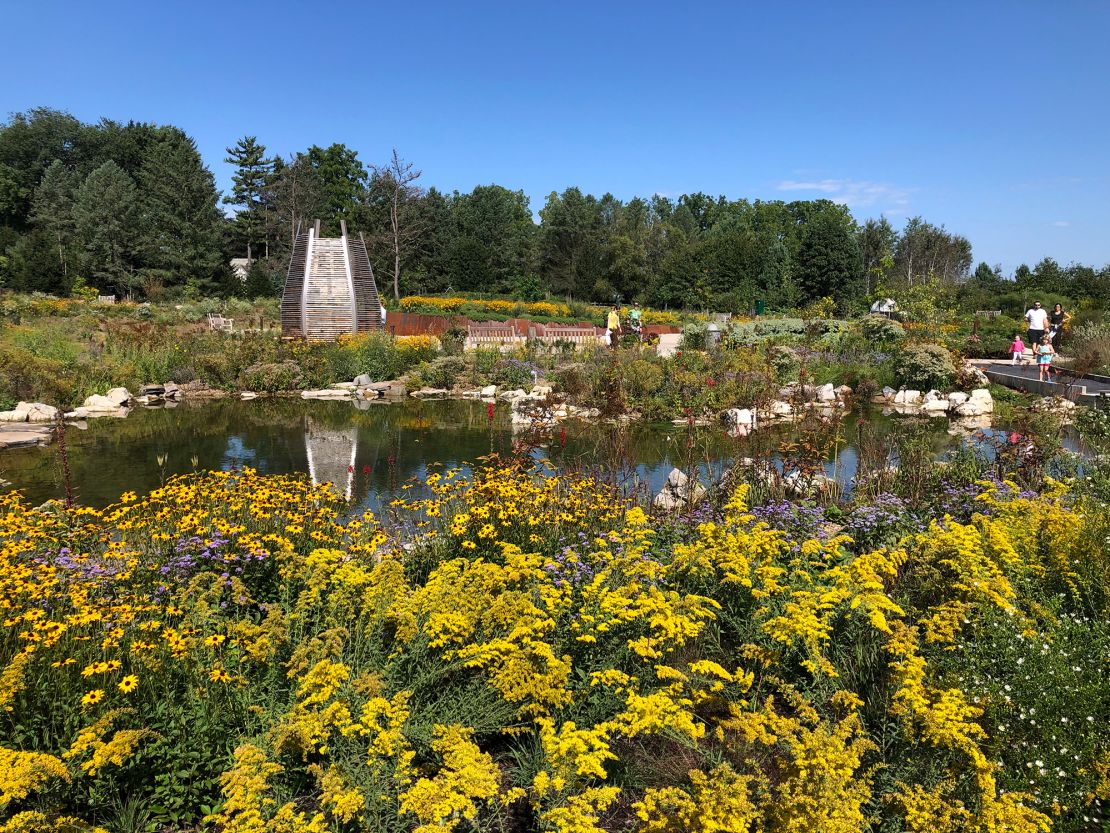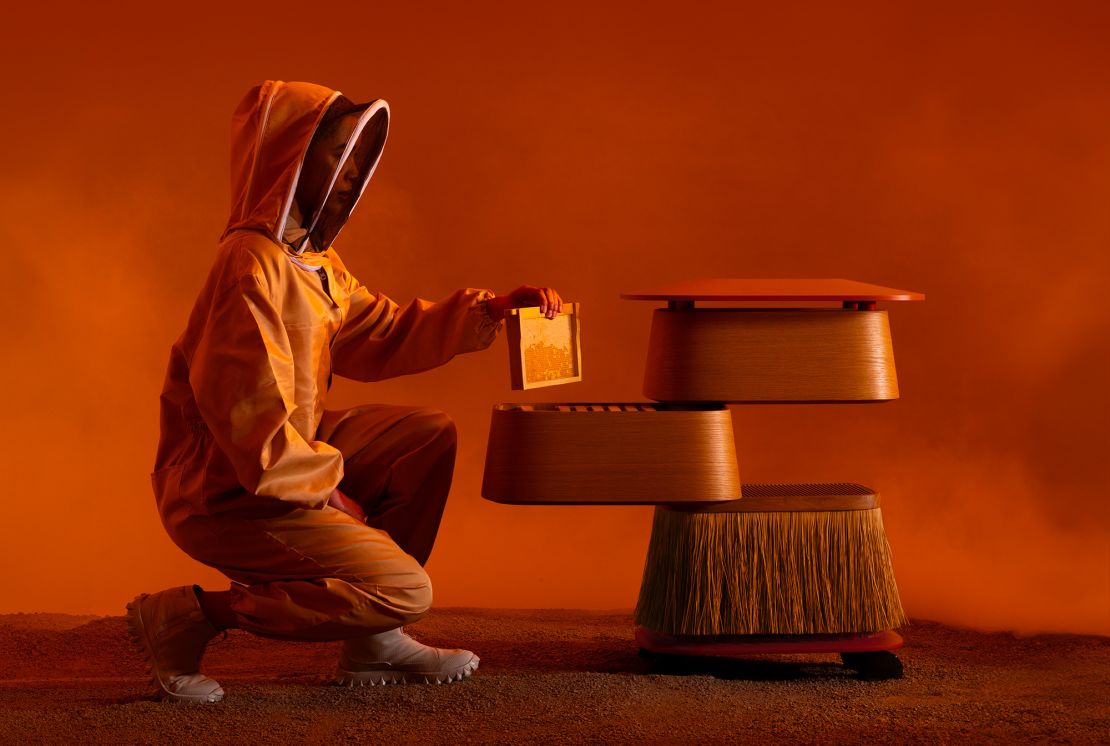CNN
—
“If pollinators designed gardens, what would humans see?” Over a video call, the London-based artist Alexandra Daisy Ginsberg is talking about “Pollinator Pathway,” an online tool she developed that allows users to design gardens for the benefit of pollinating insects, such as bees — many species of which are facing extinction. The planting designs are generated using an algorithm that prioritizes flowering plants that pollinators like to feed on, and the project has resulted in flower-filled gardens around the world, which Ginsberg calls “living artworks.”
The project is one of many on show at “More than Human,” an exhibition at the Design Museum in London, running until October 5. Exploring the interconnected relationship between humans and animals, plants and other living beings, the exhibition showcases ideas for how to live in better harmony with the natural world.
Bees and other pollinators, such as butterflies, wasps and hummingbirds, are essential for maintaining biodiversity and the health of the Earth’s ecosystems. As they move between flowers, to collect nectar for food, they unintentionally transfer pollen along the way, enabling the plants to reproduce. According to the United Nations, a third of the world’s food production depends on pollinators like bees.

But bee populations have been declining. In the US, the National Agriculture Statistics Service reported a reduction from 5.9 million honey-producing bee colonies in 1947 to 2.44 million in 2008. Between June 2024 and February 2025, US commercial beekeepers reported a 62% loss of their managed honeybee colonies.
“One of the main causes of declines (of pollinators) is landscape change and the decline of flowers in anthropogenic landscapes,” said Harland Patch, an assistant research professor in the department of entomology at Pennsylvania State University and co-author of “The Lives of Bees.” Scientists attribute the loss of natural, biodiverse habitat to climate change, pollution, pesticides and human-driven development.
One of the key ways to support bees is ensuring they have a diverse array of flowers to feed on. Architects and designers, in response, have begun to plant “pollinator-friendly” gardens.
The “Alusta” pavilion from Finnish architecture practice Suomi/Koivisto, also showcased at “More than Human,” is a temporary structure and garden created in Helsinki in 2022. “We contacted a group of ecology researchers to ask if it’s possible to invite pollinators onto a paved parking lot in the center of Helsinki,” said co-founder Maiju Suomi over a video call. “They said yes, if you choose the right plants.”
With help from the ecologists, Suomi/Koivisto selected pollinator-friendly plants — such as cowslip, lemon thyme, wild strawberry, and hyssop — and arranged them around a pavilion made of clay blocks. “We wanted to make a space to represent how our fates are entangled with non-human species,” said Suomi. “If they don’t survive, we don’t survive either.” Working on a project like this, she added, “you start understanding how we as designers can make decisions that support those relationships rather than break them.”
At the Arboretum at Penn State University, a park and botanical garden complex, a special Pollinator and Bird Garden was created in 2021 to attract local pollinating insects and birds. Designed by Didier Design Studio, Claudia West and Phyto Studio, the garden features flowering plants including goldenrods, native mountain mint, and fennel. The designers organized the planting to ensure it looked beautiful while fulfilling a scientific purpose.

One of the aims of the garden is to inspire visitors to do their own pollinator-friendly planting, if they have the resources. “The primary rule is plant as many flowering plants as you can,” said Patch, the research scientist from Penn State, who is also director of pollinator programming at the Arboretum. “Start plant clubs and get your neighbors, your town, to do the same. In the 21st century, we should be shocked if a neighborhood is not filled with flowers.”
As well as flowers to feed on, designers have created innovative homes for bees to shelter and nest in, hoping to help them survive. While beehives — manmade structures within which honeybees can nest and produce honey — have been created for millennia, designs continue to develop. At this year’s Milan Design Week, a new beehive called “Host” was unveiled by London-based industrial design studio Layer in collaboration with Spanish furniture manufacturer Andreu World.
The modular design, in timber, metal and straw, evolves the typical beehive model of stacked boxes. “We analyzed existing beehives and saw some opportunities to improve them,” said Layer founder Benjamin Hubert over a video call. The “Host” design features efficient ventilation and rain coverage, as well as straw insulation around the brood chamber to keep the bees warmer in cold temperatures — all to improve the beehive’s “livability,” Hubert said.

French artist and designer Marlene Huissoud created a special beehive at the SFER IK Museum in Mexico for the Melipona bee, a local species facing population decline. The beehive, named “Mama,” resembles a dynamic group of tree trunks. “It’s like a tree that has different channels, and each one has a different swarm of bees living inside,” explained Huissoud over a video call. She collaborated with a local beekeeper to design a structure that would be “comfortable” for the bees, giving them maximum privacy from human onlookers.
Huissoud’s father was a beekeeper, instilling in her as she grew up a fascination with the insects. “Living with bees really sparked my interest,” she said. Many of Huissoud’s pieces are designed as habitats for bees and other pollinators, and her “Please Stand By” chair in clay, dotted with holes for insects to nest in, is on show at “More than Human.”
Beehives are only for honeybees, however, which represent only a small portion of the approximately 20,000 bee species globally. Many species are solitary, meaning they like to nest alone. So-called “bee hotels” use bundles of hollow canes or wooden logs drilled with holes, within birdhouse-like wooden structures, to recreate the natural habitats that solitary bees like to nest in. Versions populate many gardens and parks all over the world, including the Arboretum at Penn State.
In 2020, Copenhagen-based designer Tanita Klein teamed up with design studio Bakken & Bæck and Space10, IKEA’s former research and design lab, to create “Bee Home,” a modular, Tetris-like bee hotel design in timber. As an open-source parametric design, users can use an online tool to select the size, height and style that suits their taste, and download the design files for fabrication. The resulting structures resemble miniature city towers in wood, patterned with window-like holes for nesting in.
Specially designed hole-studded architectural bricks (dubbed as “bee bricks”) can be used in building exteriors or garden walls to provide nesting opportunities for solitary bees. In the English city of Brighton, such bee bricks have been made a necessary condition of planning approval for most new buildings.
Suomi, the architect from Suomi/Koivisto, sees “direct” design interventions such as these as important, but also points to the ways in which designers can support bees and other pollinators through “indirect” actions. “Climate change alters the living conditions for all living beings, making them worse in most cases, and accelerating the loss of biodiversity,” she said. “All of our design decisions that are not combatting climate change, are making the living conditions of all non-humans and humans worse.”






























